The "Creuseurs" ("diggers"), at the centre of the world's push for EVs, are in peril
Part One – The precarious reality of artisanal mines
Electronics Watch travelled to Kolwezi in the province of Lualaba, in the south of the Democratic Republic of Congo. Two worlds live side by side here, without ever crossing paths. On the one hand, the world of industrial mines, with their huge machines. On the other, the tens of thousands of "diggers" in small-scale artisanal mines, armed with a simple crowbar to exploit a mineral vein, in extremely dangerous conditions. The DRC alone has 80% of the world's cobalt stocks needed to manufacture batteries to serve the demand for electric vehicles, and no less than 30% of this stock is mined in an artisanal way. One to two million Congolese people depend on this production directly or indirectly, while world demand is booming.
Our first experience was striking: we went next to the Commus industrial mine, which adjoins the town of Kolwezi, that became famous because of forced relocation of local communities as reported recently by Amnesty International. Around two hundred young men wait patiently for nightfall to climb first the perimeter wall, then the vertiginous embankment, to steal a few kilos of blue gold, cobalt's nickname. While the soil in the south of the country is rich in copper and cobalt, the difficulty lies in accessing the seams, which are often 10 metres deep or more. In some mines, the guards do not hesitate to let their dogs loose or to fire live ammunition, according to our monitoring partners Southern Africa Resource Watch (SARW) and Centre d’Aide Juridico-Judiciaire (CAJJ).
Driving around Kolwezi, you quickly sense the strong nostalgia felt by the inhabitants for the heyday of Gécamines, the state-owned mining company, before the process of dismantling and privatising mining began in 2003. That those glory days are long past is evident, with many industrial and community buildings unoccupied or in a state of disrepair.
When it comes to the large, industrial mines, no fewer than 15 Chinese operators share the pie with other major players of similar weight, Glencore and Eurasian Resources Group. It's very difficult to get inside these heavily-guarded enclosures, whose embankments are so high that they can be seen from ten kilometres away. According to the trade unions we met, freedom of association is not a major problem, and several mines even have collective agreements. However, according to sources that are difficult to verify, more than half the workers are employed by subcontractors who do not enjoy the same working conditions.
The world of cooperatives is radically different. Unlike in Bolivia, where we recently visited as well, there are rarely elections to appoint leaders. Cooperative mines are often run by a handful of individuals, sometimes in a "dynastic" fashion. Here, there is generally no machinery, but thousands (2,000 - 20,000) of workers who work alternately on a rotation. The men go from one mine to another in search of work. As for the women, they are subject to prejudice and discrimination. Sometimes nicknamed "snakes", supposed to bring misfortune according to traditional beliefs, accused of making the veins disappear, they are nevertheless beginning to be authorised to work here and there. Women's cooperatives are forming to join forces, as demonstrated by the establishment of a federation of women miners' and farmers' cooperatives.
The "diggers", some of whom appear to be teenagers, dig tunnels without any protection. However, the state is present, represented by SAEMAPE (Service d'Assistance et d'Encadrement de l'Exploitation Minière Artisanale et à Petite échelle), which is supposed to check the installations, but it soon becomes apparent that mining is carried out in conditions that contravene all the most basic safety rules. At best, the tunnels are shored up with simple tree trunks. There is no escape tunnel if the main gallery collapses, air is pulsed by electrical equipment barely larger than a hairdryer, and the miners neither wear, nor wish to wear, any personal protective equipment. Miners do not wear even a simple helmet or suitable footwear. Talking about dust and ear protection seems to be a good joke there.
Risk prevention is virtually non-existent; the emphasis is on managing accidents after the fact. Despite the presence of an infirmary or first-aid posts, or even an ambulance, it would be impossible for us to obtain data on serious or fatal accidents.
However, with the help of subsidies from NGOs and other development aid bodies, some cooperatives are timidly beginning to move closer to international standards such as those set by the OECD and the EU, for example. Prevention signs at the entrances to the sites remind us that child labour, pregnant women and night work are prohibited. In fact, on this last point, mine hours seem to be fixed (between 8am and around 5pm).
Good practice is also emerging, as shown by the example of a cooperative that has managed to eradicate the "digger" tunnels by excavating open pits using industrial machinery. This very costly operation is financed by the Chinese "partners" present on the site, who buy the minerals. With no access to the banking system, this is the only way for the cooperatives to finance the discovery of deeply buried ore.
Thanks to funding from EPRM and the city of Barcelona, our team had the opportunity to help train leaders of cobalt and copper mining cooperatives in Kolwezi on Due Diligence and Human Rights, with the support of our local partners. These cooperative leaders often bear witness to the unfortunate collision between the vested interests of certain elected representatives, and the mining business.
Read more about these obstacles, and the opportinites to improve conditions for miners, in part two.
Electronics Watch is grateful to EPRM and Barcelona City Council for their support of this project.

)
This article represents only the views of Electronics Watch, and donors are not responsible for its content.


